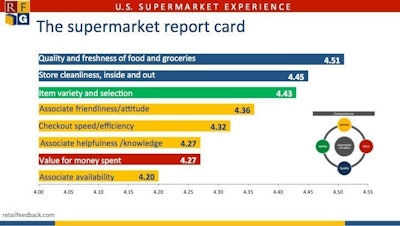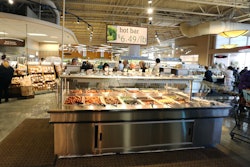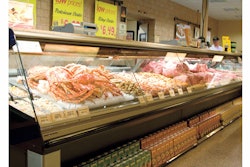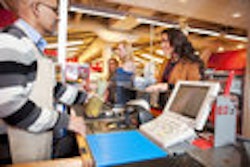
The Retail Feedback Group (RFG) released the 2016 U.S. Supermarket Experience Study today and results show that supermarkets continue to generate high satisfaction among their shoppers, as well as foster a strong referral rate to recommend quality grocery stores to others.
Some of the important takeaways from the study include:
- If shoppers could not find all items they came in to purchase, their satisfaction was significantly lower (3.92) compared to those who did find all items (4.43). This finding is a recurring theme in supermarket experience research. In-stock position must consistently be high for retailers to ensure shopper satisfaction.
- Supermarket shoppers continue to use money-saving measures but the mix of these measures is evolving. Overall, 77 percent of shoppers referred to one or more advertising or sales vehicles before or during the store visit. The top money-saving measure, used by 56 percent of shoppers, was reviewing the traditional paper circular at home. An additional 31 percent reviewed the circular in the store and 26 percent examined the circular digitally. Clipping paper coupons (obtained from newspapers or other printed sources) registered at 38 percent, while downloading digital coupons was at 27 percent and in-store promotions at 22 percent. Money-saving measures used less frequently were loyalty card offers (19 percent), smartphone research (12 percent) and social media specials (7 percent).
- Examining the use of money-saving measures by generation, the research shows that Boomers reviewed the circular at home (64 percent) and clipped paper coupons (45 percent) at much higher rates than Millennials (46 percent and 31 percent, respectively). Millennials, on the other hand, utilized smartphone research (22 percent) and social media specials (13 percent) at higher percentages than Boomers (6 percent and 4 percent, respectively).
Brian Numainville, RFG Principal, observed, "As younger generations, specifically Millennials and Generation Z, continue to grow in their spending influence over the coming years, supermarket advertising will need to increasingly blend traditional vehicles with social, mobile and digital. Retailers should carefully evaluate their markets and shopper base on an ongoing basis to ensure the right mix."
Doug Madenberg, RFG Principal noted, "Not one of the service attributes scored at the top of the core experience factors, yet it is imperative to find ways to strengthen customer service. Our research shows that when service receives high scores, the average trip satisfaction is significantly higher along with spending in the short-term and loyalty in the long-term. As a result, we can't stress strongly enough the impact that store employees have on the shopping experience, whether it is fostering a pleasant interaction, providing service above and beyond expectations, or simply being available to help."
To obtain a copy of the 2016 U.S. Supermarket Experience Study, click here.


















